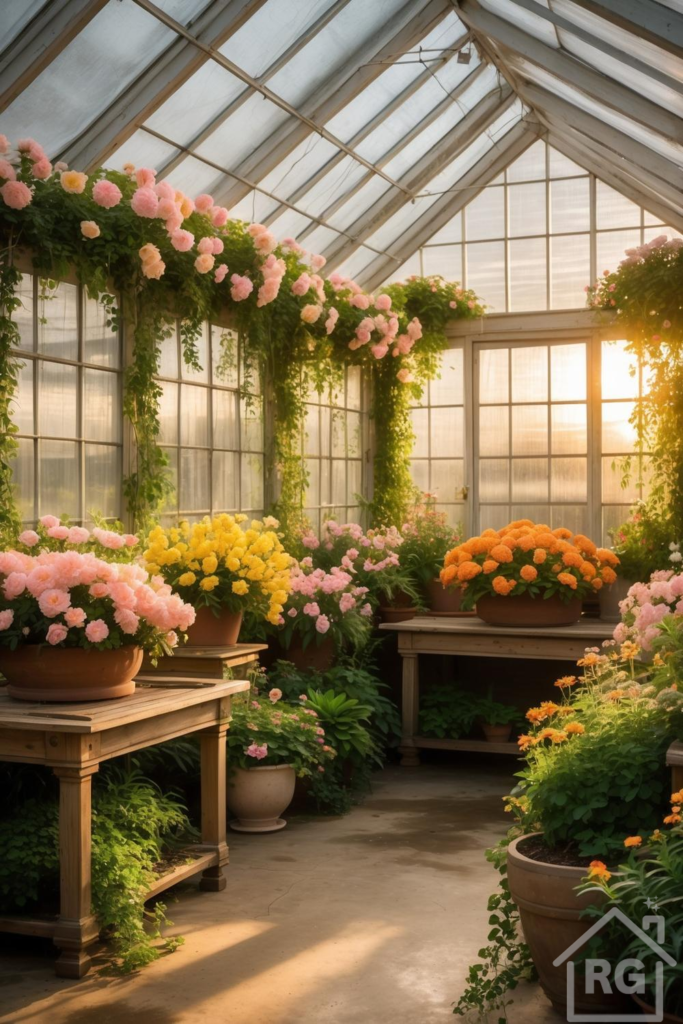
Imagine stepping into a space where the air is thick with the scent of blooming flowers, where sunlight streams through glass panels, illuminating a riot of color and lush greenery. This isn’t just a dream; it’s the essence of a well-designed greenhouse or sunroom garden. Far more than just a place to grow plants, it’s a personal sanctuary, a vibrant escape that connects you with nature year-round. If you’ve ever been captivated by the charm of a botanical haven, this guide will walk you through the steps to replicate that enchanting aesthetic in your own home.
The Vision: Replicating the Greenhouse Aesthetic
The image of a sun-drenched greenhouse, bursting with pink, yellow, and orange blooms, resting on rustic wooden benches, evokes a sense of warmth, abundance, and tranquility. The key to recreating this look lies in a harmonious blend of natural light, diverse plant life, and functional yet beautiful structural elements. It’s about creating an environment where plants thrive, and you feel utterly at peace.
Choosing Your Structure: From Grand Greenhouses to Cozy Sunrooms
The first step in cultivating your botanical sanctuary is deciding on the right structure. While a full-scale greenhouse might be the ultimate dream, there are many alternatives that can achieve a similar effect, tailored to your space and budget.
Full-Scale Greenhouse Considerations:
- Size and Location: Assess available space and choose a spot with ample sunlight, ideally south-facing.
- Material Choices:
- Glass: Offers maximum light transmission and a classic aesthetic. However, it can be more expensive and less insulating, requiring careful temperature management.
- Polycarbonate: A more affordable and durable alternative, polycarbonate panels provide excellent insulation and diffuse light, which can be beneficial for some plants by preventing scorching.
- Ventilation and Heating/Cooling: Essential for maintaining optimal growing conditions. Automatic vents, fans, and heaters or evaporative coolers might be necessary depending on your climate.
Smaller Alternatives for Limited Spaces:
- Lean-to Greenhouses: Attached to an existing wall, these are space-efficient and benefit from the thermal mass of your home.
- Sunrooms or Conservatories: These extensions of your home offer a comfortable, climate-controlled environment perfect for a wide array of plants, blending indoor comfort with outdoor views.
- Bright Corners or Bay Windows: Even a well-lit corner with shelving and grow lights can serve as a mini-greenhouse for a curated collection of plants.
Planting Paradise: Selecting Your Botanical Beauties
The heart of any greenhouse is its plant collection. To achieve the vibrant, abundant look, focus on a mix of flowering plants and lush foliage.
Vibrant Flowering Plants:
- Soft Pinks: For the delicate pink blooms seen cascading from above, consider climbing roses or vigorous varieties of petunias, impatiens, or fuchsias. These can be trained to climb trellises or hang gracefully from baskets. Other excellent choices for potted pink flowers include begonia, cyclamen, and specific varieties of geraniums.
- Sunny Yellows and Oranges: To introduce cheerful bursts of color, opt for marigolds, calendula, nasturtiums, or coreopsis. Dwarf sunflower varieties can also bring a touch of sunshine to larger pots. These plants generally love bright light and will thrive in a greenhouse environment.
- Complementary Colors: Don’t be afraid to introduce other colors for depth. A touch of deep blue lavender or purple delphiniums can provide a striking contrast, while white petunias or alyssum can brighten the space and act as a visual resting point.
Lush Greenery & Trailing Vines:
- Foliage First: While flowers grab attention, lush green foliage provides the essential backdrop and texture. Ferns, hostas, calatheas, and various philodendrons offer diverse leaf shapes and shades of green.
- Graceful Trailing Vines: To mimic the cascading greenery, incorporate plants like pothos, string of pearls, or ivy. These can be placed on high shelves or in hanging baskets, allowing their tendrils to spill downwards, softening the hard lines of the structure.
Climate Considerations:
Group plants with similar needs for light, humidity, and temperature. A greenhouse allows you to control these factors more precisely than an outdoor garden. Research the specific requirements of your chosen plants to ensure their success.
Material Matters: Durability and Aesthetics
The materials you choose for your greenhouse’s interior elements contribute significantly to its overall look and feel.
Potting Benches and Tables:
The rustic wooden benches in the inspiration image are both functional and beautiful.
- Wood: For a natural, warm aesthetic, opt for rot-resistant woods like cedar, redwood, or treated pine. Ensure they are sealed or treated to withstand the high humidity of a greenhouse. Consider different heights and configurations to create visual interest and practical workspaces.
- Metal: Galvanized steel or aluminum benches offer durability and a more industrial or modern look. They are resistant to rot and pests.
- Arrangement: Use benches to elevate plants, creating layers and making watering and care easier. A mix of tall and short stands adds dynamic visual appeal.
Pots and Planters:
The classic terracotta pots seen in the image are a timeless choice.
- Terracotta: These unglazed clay pots are breathable, allowing roots to get air and preventing waterlogging. They are excellent for plants that prefer drier conditions, though they do require more frequent watering. Their earthy, reddish-brown hue complements all plant colors.
- Ceramic: Glazed ceramic pots come in an endless array of colors and finishes, offering more decorative options. They retain moisture better than terracotta.
- Plastic: Lightweight, affordable, and excellent at retaining moisture, plastic pots are practical, especially for larger plants that need frequent watering.
- Concrete/Stone: Heavy and durable, these provide a solid, architectural look, perfect for larger specimen plants.
- Mix and Match: Don’t be afraid to combine different materials and sizes of pots to add character and texture to your display.
Flooring:
The floor of your greenhouse needs to be durable, easy to clean, and provide good drainage.
- Concrete: A popular choice for its durability, ease of cleaning, and ability to absorb and release heat, helping to regulate temperature. Ensure it’s sloped slightly towards a drain.
- Gravel: Provides excellent drainage and a rustic, natural feel. It also helps increase humidity as water evaporates from it.
- Pavers or Tiles: Can offer a more finished and decorative look, but choose non-slip varieties and ensure proper drainage underneath.
Arrangement and Layout: Designing Your Botanical Haven
Thoughtful arrangement transforms a collection of plants into a cohesive, inviting space.
- Vertical Gardening: Maximize space by utilizing vertical elements. Install shelves, hanging hooks for baskets, or trellises for climbing plants. This adds depth and allows more plants in a smaller footprint.
- Layering: Create visual interest by layering plants. Place taller plants at the back or center, medium-sized plants in the middle, and shorter or trailing plants at the front or along edges of benches.
- Pathways: Ensure clear, accessible pathways for easy movement, watering, and plant care.
- Zoning: If your space allows, create different zones: a propagation area, a display area for your most beautiful blooms, or sections for plants with specific environmental needs.
- Comfortable Seating: Even a small stool or a comfortable chair can transform your greenhouse into a true retreat where you can sit and enjoy your botanical creations.
DIY Touches and Personalization
Infuse your personality into your greenhouse with creative DIY projects.
- Repurposed Items: Old wooden crates, vintage ladders, or antique shelves can be repurposed into unique plant stands or display units, adding character and a sense of history.
- Custom Potting Mix: Learn to blend your own potting mixes tailored to the specific needs of your plants, ensuring optimal growth and health.
- Hand-Painted Pots: Give plain terracotta or plastic pots a personal touch with a coat of paint or decorative stencils.
- Simple Irrigation Systems: For larger collections, consider installing a basic drip irrigation system to save time and ensure consistent watering.
Creating Ambiance: Beyond the Plants
To truly make your greenhouse a sanctuary, engage all the senses.
- Lighting: While natural light is paramount, consider supplemental grow lights for darker days or winter months. For evening ambiance, string lights (solar-powered or low-voltage) draped across the ceiling or around shelves can create a magical, warm glow. Small lanterns or LED candles can also add charm.
- Sound: A small, self-contained water feature can introduce the soothing sound of trickling water, enhancing the peaceful atmosphere.
- Scent: Choose fragrant plants like jasmine, gardenia, citrus trees, or scented geraniums to fill the air with delightful aromas.
- Decor and Tools: Display attractive gardening tools, vintage watering cans, small sculptures, or botanical prints to add decorative elements that complement the natural beauty of the space.
Maintenance for Longevity
A thriving greenhouse requires consistent care.
- Watering and Feeding: Establish a regular watering schedule based on plant needs and monitor soil moisture. Provide appropriate fertilizers during growing seasons.
- Pest and Disease Management: Regularly inspect plants for signs of pests or diseases and address them promptly using organic or appropriate treatments. Good air circulation helps prevent many issues.
- Pruning and Deadheading: Keep plants healthy and encourage new growth and blooms by regularly pruning and removing spent flowers.
- Cleaning: Periodically clean the glass panels and interior surfaces to maximize light transmission and maintain a tidy appearance.
Creating a greenhouse or sunroom garden is a rewarding endeavor that brings the beauty and tranquility of nature directly into your life. By thoughtfully selecting your structure, plants, materials, and adding personal touches, you can cultivate a vibrant botanical sanctuary that offers endless joy and a peaceful escape from the everyday. Start planning your green haven today!
